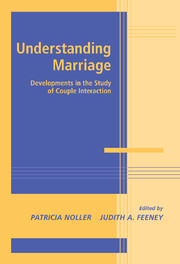Book contents
- Frontmatter
- Contents
- Contribitors
- Introduction
- SECTION ONE THE EFFECT OF COGNITION ON INTERACTION PATTERNS
- SECTION TWO UNDERSTANDING THE IMPORTANCE OF POSITIVE INTERACTION
- SECTION THREE COPING WITH DISAPPOINTMENT, CRITICISM, AND BETRAYAL
- SECTION FOUR POWER, CONFLICT, AND VIOLENCE IN MARITAL INTERACTION
- Introduction to Section Four
- 11 Demand-Withdraw Communication during Couple Conflict: A Review and Analysis
- 12 Approaches to the Study of Power in Violent and Nonviolent Marriages, and in Gay Male and Lesbian Cohabiting Relationships
- 13 The Communication of Couples in Violent and Nonviolent Relationships: Temporal Associations with Own and Partners' Anxiety Arousal and Behavior
- Marital interaction at important transition periods
- SECTION SIX Interventions for strengthening relationships
- Conclusions
- Index
- References
12 - Approaches to the Study of Power in Violent and Nonviolent Marriages, and in Gay Male and Lesbian Cohabiting Relationships
Published online by Cambridge University Press: 25 July 2009
- Frontmatter
- Contents
- Contribitors
- Introduction
- SECTION ONE THE EFFECT OF COGNITION ON INTERACTION PATTERNS
- SECTION TWO UNDERSTANDING THE IMPORTANCE OF POSITIVE INTERACTION
- SECTION THREE COPING WITH DISAPPOINTMENT, CRITICISM, AND BETRAYAL
- SECTION FOUR POWER, CONFLICT, AND VIOLENCE IN MARITAL INTERACTION
- Introduction to Section Four
- 11 Demand-Withdraw Communication during Couple Conflict: A Review and Analysis
- 12 Approaches to the Study of Power in Violent and Nonviolent Marriages, and in Gay Male and Lesbian Cohabiting Relationships
- 13 The Communication of Couples in Violent and Nonviolent Relationships: Temporal Associations with Own and Partners' Anxiety Arousal and Behavior
- Marital interaction at important transition periods
- SECTION SIX Interventions for strengthening relationships
- Conclusions
- Index
- References
Summary
To the outsider, mathematics is a strange, abstract world of horrendous technicality, full of symbols and complicated procedures, an impenetrable language and a black art. To the scientist, mathematics is the guarantor of precision and objectivity. It is also, astonishingly, the language of nature itself. No one who is closed off from mathematics can ever grasp the full significance of the natural order that is woven so deeply into the fabric of physical reality.
—Paul Davies, The Mind of God, 1992, p. 93THE STUDY OF POWER
In the 1950s Fred Strodtbeck's research on marriages in three cultures made the study of power look easy (Strodtbeck, 1951). He drove a van through the Western United States and asked Mormon (patriarchal), Navajo (matriarchal), and Anglo Texan (supposedly egalitarian) married couples to go into the back of his van, and gossip about families the couple thought were raising their kids poorly or well (something that couples in all three cultures found it easy and natural to discuss) and have some structured marital disputes. The marital disputes involved having each spouse fill out a questionnaire indicating personal preferences (like what kind of car to buy, what to order for dinner), and then the couple doing this task again by discussion. The more powerful person was defined as the person who was closer to the joint decision on his or her personal preferences.
- Type
- Chapter
- Information
- Understanding MarriageDevelopments in the Study of Couple Interaction, pp. 323 - 347Publisher: Cambridge University PressPrint publication year: 2002
References
- 9
- Cited by

